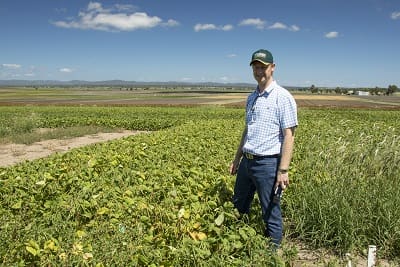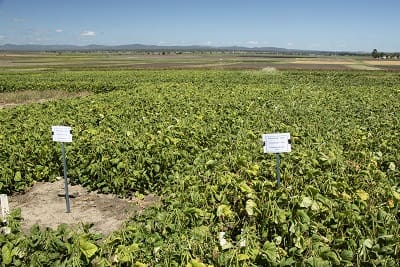
Queensland DAF lead researcher, Dr Michael Widderick, is conducting mungbean and sorghum crop trials to better understand the agronomic factors that increase the crop’s competitive advantage over feathertop Rhodes grass and awnless barnyard grass.
EVIDENCE is mounting that summer crops really can be an effective weapon in the war on herbicide resistant weeds.
With soil moisture at a premium, there is nothing spare to waste on summer-growing weeds.
With four of the most difficult to control summer weeds, feathertop Rhodes grass (FTR), awnless barnyard grass, common sowthistle and flaxleaf fleabane, now with confirmed cases of glyphosate resistance, the pressure is on to find effective non-herbicide control tactics.
These weeds can produce 40,000, 42,000, 25,000 and 110,000 seeds per plant respectively.
Other studies have found these numbers could be even higher, so every effort to reduce seed production is worthwhile.
Various trials in mungbean, soybean and sorghum crops have consistently found that planting these summer crops in competitive configurations can reduce weed biomass and seed production while maintaining or increasing crop yield.
The change in row configuration may involve set up costs to modify planting equipment but does not require an increase in seeding rate as the effect has been demonstrated using the same established populations for mungbean and soybean.
“As a non-herbicide control tactic, crop competition is very important in any integrated weed management program.”
For sorghum, the competitive edge comes through increased plant population rather than narrower rows.
Along with narrowing the row spacing in mungbean and soybean, there are also benefits in early weed control.
Keeping crops weed-free for the first three to six weeks seems to be a valuable rule of thumb to give crops the head start required to drive down weed numbers.
Weeds that germinate in-crop after the 3–6-week mark are fewer in number and individual plants also produce less seed.
As a non-herbicide control tactic, crop competition is very important in any integrated weed management program.
With investment from the Grains Research and Development Corporation (GRDC), researchers from NSW Department of Primary Industries, University of Sydney and Queensland Department of Agriculture and Fisheries are conducting trials to identify ways to increase the competitiveness of sorghum and summer pulses.
In the 2017–18 summer sorghum was sown in trials using three row spacings (50, 75, 100 centimetres) and two crop densities (5 and 10 plants per square metre).
In a separate trial, mungbean plots were established using three row spacings (25, 50 and 75cm) and two crop densities (20 and 35 plants per m2).
Seed of feathertop Rhodes grass and awnless barnyard grass was spread at planting and the plots were irrigated to ensure optimal crop and weed emergence.
With only one year of data from this trial so far it is difficult to make recommendations. Average seed head production in non-crop treatments was 1745 heads/m2 for feathertop Rhodes and 1525 heads/m2 for awnless barnyard grass.
Growing either crop more than halved the number of weed seed heads produced, even in the least competitive configuration for the two crops.
Row spacing in mungbean had a clear impact on weed seedhead production for both weed species. This effect has been demonstrated numerous times in a range of agronomic trials with mungbean.
Narrowing row spacing to 25cm reduced feathertop Rhodes grass seed heads to 32 per m2.
For awnless barnyard grass, narrowing row spacing to 50cm or less reduced seed heads to less than 10 per m2.

In these plots, mungbean sown on row spacing 25cm at low crop density (20 plants/m2) competing strongly with both awnless barnyard grass (left) and feathertop Rhodes grass (right).
For sorghum it seems increased plant population had the best effect, significantly reducing weed seed head numbers for both weed species.
Unlike mungbeans and soybeans, sorghum yields were reduced in plots with narrower row spacing configurations.
At each row spacing, the higher plant density (10 plants/m2) treatment yielded more than the lower density plant population.
In a separate trial, University of Queensland researchers confirmed that row spacing, not plant population, is the key driver to reducing weed growth in soybean crops.
In soybeans, weed biomass was reduced by 89 per cent under narrow rows (25cm) and 75pc under wider rows (75cm) when the crop was kept weed-free for the first three weeks after planting.
If weeds were controlled for the first six weeks, then weed biomass was reduced by 98p under narrow rows and 88pc under wider rows.
In weed-free plots there was a 20pc yield benefit in changing from 75cm row spacing to 25cm.
This yield difference was 65pc in plots where weeds were introduced six weeks after planting and a huge 121pc higher when the weed infestation occurred three weeks after planting.
Similarly, if a mungbean crop is kept weed-free for the first three weeks after planting, then the narrower row spacings of 25 and 50cm saw a reduction in weed biomass.
In both the 2015 and 2016 summers, the combination of keeping the crop weed-free for at least the first three weeks and planting on the narrower rows (25 or 50cm rather than 75cm) generated a yield increase of 159–197pc in 2015 and 198–223pc in 2016.
Summer crops are an integral part of many farming systems and play an important role in an integrated weed management program.
Many summer weeds only remain viable on the soil surface for a period of around 12 months so if a competitive summer crop is followed with a competitive winter crop and harvest weed seed control, it is possible to have a real and lasting impact on the weed seed bank.
Source: WeedSmart, www.weedsmart.org.au

HAVE YOUR SAY